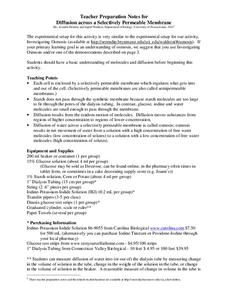Curated OER
Passive and Active Transport
In this transport learning exercise, students compare and contrast the characteristics and examples of active transport and passive transport. This learning exercise has 1 graphic organizer and 11 short answer questions.
Gallantsbiocorner.com
Cell Membrane & Transport
Young scientists demonstrate their understanding of cell transport on this comprehensive worksheet. Focusing on cellular structure and the different processes that allow materials to move into, out of, and throughout animal cells, this...
Curated OER
Transport Starts With?
A fill-in-the-blank worksheet regarding transport, this handout would make a great study guide or quick homework assignment to help learners ensure they know the key vocabulary for this topic. There is no answer key, but these are...
Curated OER
Vocab Chapter Seven: Transport
A note-taking resource for the topic of transport between cells. If formatting is important to you, there are some slight changes you'll need to make to this Word document to make it consistent.
Curated OER
Cell Structure and Function
In this cells worksheet, learners review the different types of cells. Students identify the organelles found in an animal cell and determine the function of these organelles. This worksheet has 14 matching, 6 fill in the blank, and 5...
Curated OER
Diffusion Across a Selectively Permeable Membrane
Students investigate how water passes through cell membranes. In this biology lesson, students differentiate osmosis and diffusion. They illustrate the movement of water in both processes.
Curated OER
Study of the Cell
Students draw a diagram to show the fluid mosaic model of a membrane. They explain how hydrophobic and hydrophilic properties help membranes hold their shape. They identify the functions of different cell membrane proteins as well.








